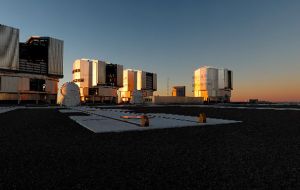MercoPress. South Atlantic News Agency
Chilean mountains hold the world’ largest space research infrastructure
 The Paranal Observatory, the largest of its kind
The Paranal Observatory, the largest of its kind The Chilean Foreign Ministry officially signed over a total of 213 square miles of land to the European Organization for Astronomical Research in the Southern Hemisphere (ESO) last Thursday to begin construction of the world’s largest optical telescope, the European Extremely Large Telescope (E-ELT).
The mega-telescope has a one-of-a-kind aperture mirror measuring 131 ft in diameter that will allow scientists from Chile and around the world to search for Earth-like planets that might sustain life.
Cerro Armazones, a mountain in the Antofagasta Region, is at the centre of the73 square mile plot of land where the telescope will be built. The government has also granted a 50-year concession on a 140 square mile piece of land to act as a protection barrier around the mountain that will bar all mining operations and infrastructure causing light pollution from being built.
The property used for the E-ELT will join with the adjacent 278 square mile property that is home to the Paranal Observatory, also owned by ESO, to create the 490 square mile Paranal-Armazones park, the largest of its kind in the world, and an initiative that will also house the best optical telescope, the E-ELT, and infrared telescope, the Very Large Telescope (VLT) - the one that is most active and to be used by the best astronomers in the world.
“This will be the best and largest astronomical park in the world [and] this [would not be] possible in any other part of the world,” director of ESO, Tim de Zeeuw, said at the ceremony granting the land to the ESO.
The Atacama Desert of the Antofagasta Region has some of the best skies for viewing the great beyond with 330 nights of clear skies every year.
Even so, María Teresa Ruiz, an astronomer at the Universidad de Chile and the 1997 recipient of the National Prize for Exact Physical Sciences told El Mercurio that, “there were many months when Chileans had to convince and guarantee us that this was really the best location.”
The ESO had to ask for 1.5 million dollars from each 15 associates last March in order to collect enough money to begin the project. Construction should begin in the beginning of 2012 and should be finished in 11 years.
The E-ELT is the largest investment in infrastructure for space exploration in Chile, representing more than 50% of the total amount invested in ALMA, the largest radio telescope project in the world that is currently under construction in San Pedro de Atacama.
Chile currently has 42% of the world’s astronomical infrastructure, and with the addition of E-ELT and other projects, this figure will soon rise to 70%.
Much of the allotted time at this observatory will be devoted to Chile’s scientists with 10% reserved solely for Chilean astronomers, 7.5% for projects led by Chileans with the collaboration of scientists from other countries and 2.5% exclusively for national projects.
“National experts are going to have much more time [for their projects] than any of the astronomers from other countries. This will allow us to do good research,” said the director of the Department of Astronomy at the Universidad Católica, Andreas Reisenegger.
By Anna Pope – The Santiago Times




Top Comments
Disclaimer & comment rulesCommenting for this story is now closed.
If you have a Facebook account, become a fan and comment on our Facebook Page!